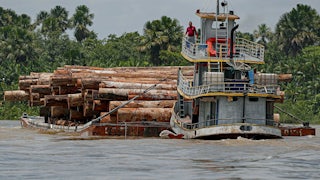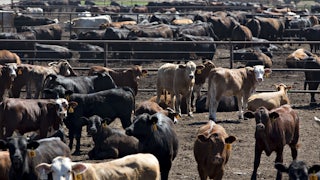A scraping sound reverberated from the hull as our tiny wooden boat once again juddered to a halt, sending us lurching forward. One of our two-man Indigenous crew jumped from the stern into the shin-deep brown water and began to push the boat sideways in time to sudden bursts from the 10 horsepower motor. Eventually, with more grinding noises and much shouting, the boat swung around 90 degrees and floated free.
For more than 14 hours, from before dawn until after dusk, this scene repeated itself again and again as I traveled on a reporting trip up the remote Tahuamanu River near Peru’s border with Brazil, late last year. As the endless jungle fell away, we continually ran aground in water that was, at times, just inches deep or found our path blocked by a maze of decaying tree trunks poking out of the shallows. A journey that should have taken six hours stretched into two days, with a forced impromptu overnight encampment on the banks.
River depth can fluctuate wildly in the Peruvian Amazon. But what was out of the ordinary—and had our local crew perplexed—was the timing, in late November. That was at least a month after the rains should have started soaking the Andes Mountains, the runoff lifting the level of the river by several feet and allowing for uninterrupted travel. Instead, this part of the upper Amazon was racked by a historic drought, one triggered by climate change and which saw water levels drop to their lowest since measurements began 120 years ago. It is the latest indicator that this vast, spectacular biome may be hitting a “tipping point”: the term for when deforestation becomes a self-propelling doom loop. Climate change–induced deforestation will release yet more carbon into the atmosphere, in turn triggering more droughts, die-off, and even fires in new swaths of the forest. Preventing that would require a massive and complicated international effort—one that Donald Trump’s reelection in November would almost certainly prevent.
The drought late last year largely flew under the radar of major English-language media. But it is part of an emerging pattern as climate change accelerates. Similar supposedly generational droughts hit various parts of the basin in 2005, 2010, 2015, 2016, and 2020, with fires—an anomaly in what is after all a rainforest—breaking out at scale in the basin for the first time in 2019.
In February, two months after my trip, Nature published the latest blockbuster scientific study about the risk of an imminent Amazonian tipping point, effectively warning that the biggest threat to the rainforest is no longer logging, mining, damming, ranching, or the expansion of the agricultural frontier but climate change itself, often on its own but sometimes also turbocharged by a localized symbiotic relationship with these activities. As much as 47 percent of the Amazon, the report warned, could find itself spontaneously transforming into savannah by 2050 as higher temperatures, less rain, and fire tighten their grip.
The demise of the world’s largest tropical rainforest, nearly the size of the contiguous United States, would mean a loss of biodiversity on a scale only seen a handful of times since the dawn of evolution, and tragedy for the native cultures who over thousands of generations have relied on the forest’s flora and fauna. It would alter global precipitation patterns: Currently, the Amazon generates rain clouds that irrigate agriculture from the bread baskets of Argentina to even the U.S. Midwest. Yet these effects would arguably pale in comparison to the amount of carbon that the collapse of the Amazon, or large chunks of it, would pump into the atmosphere. The basin warehouses, depending on your source, between 120 billion and 200 billion tons of carbon—equivalent to more than five years of emissions from global fossil fuel consumption at 2023 levels. As the window to avert catastrophic climate change and keep global temperature rises below two degrees Celsius (3.6 Fahrenheit) rapidly narrows, preventing that huge, unprecedented pulse of greenhouse gas emissions will require a concerted and increasingly urgent international effort, from policymakers both in Amazonian nations and the developed world, especially the U.S.
So far, they have flunked the test. “There’s a lack of political will,” warns World Wildlife Fund climate change head Manuel Pulgar Vidal, a former environment minister of Peru. “We should be very concerned. This decade will be decisive. There’s a lot of pessimism and frustration around the implementation of the Paris protocol, which is going very slowly. If we don’t get a grip on this, the consequences could be catastrophic.”
The Biden administration could arguably have done more to help focus global decision-makers’ minds on the issue. But in addition to being consumed by other international crises, from Ukraine to the Middle East, it has also rightly been aware of the hair-trigger sensitivities around U.S. power in Latin America, a region that has frequently been on the wrong end of Washington’s geopolitical machinations. USAID does have programs on Amazonian conservation, however, including in the two largest Amazonian national territories, Brazil and Peru. Meanwhile, the Inflation Reduction Act, the most significant piece of climate legislation ever, does at least give Biden some moral high ground, should he be reelected, from which to prod other governments towards urgent climate action.
Trump’s greatest climate policy achievement, by contrast, was taking the U.S. out of the Paris Agreement. While criticized as weak and insufficiently binding, the agreement is widely viewed as the strongest—or least bad—international climate change treaty to date, something to be built upon, not ripped up. Trump’s climate denial, his enthusiasm for incinerating hydrocarbons, attraction toward authoritarian leaders, and hostility to democratic institutions and the rule of law could all undermine efforts to halt and reverse deforestation in the Amazon.
Most Amazonian countries face serious governance issues, especially in remote rainforest frontier zones where state institutions, including law enforcement, are often most notable by their absence. Illegal loggers, miners, and settlers routinely test the limits of what they can get away with, including razing the forest and murdering anyone who stands in their way. Several Amazonian countries are unlikely to welcome Western attempts to troubleshoot the situation: These include Venezuela, the only nation with larger oil reserves than Saudi Arabia, and Bolivia, where the socialist government has long favored Andean Indigenous identities over those of native Amazonians.
But the problem is just as acute in countries where Washington may have more sway. Peru, whose chunk of the Amazon is twice the size of California and second only to Brazil’s, is traditionally a U.S. ally. But its democracy and public institutions have been under assault from a conservative, deeply despised Congress, with just 6 percent approval, which has been passing a series of counterreforms hobbling anti-corruption prosecutions and favoring illicit economies. The most egregious, perhaps, is a reform this year to Peru’s forest law that legalizes most deforestation, including on untitled tribal land, if there is now agriculture on that land. In other words, if a logger plants a few bananas or cassava trees, then ipso facto the deforestation becomes legal.
Germany, the U.K., and Norway have warned that this legislation threatens Peru’s international climate commitments. The United Nations’ special rapporteur on Indigenous rights has even sounded the alarm that it could fuel further violence against native communities defending their territories. So far, Peruvian lawmakers have appeared impervious to frantic back-channel efforts, including from the U.S., to revert the law. New elections are due in April 2026 at the latest, and a new cohort of legislators might be more susceptible to international pressure. The question, however, is whether the next U.S. administration will actually be paying attention, never mind seeking to encourage human rights, governance, and the conservation of irreplaceable, carbon-rich ecosystems.
“It’s not about left or right. We’ve learned that the hard way. They all base their polices on an extractivist model that doesn’t take into account the rights of nature or Indigenous peoples,” warns Gregorio Mirabal, a leader of Venezuela’s Kurripako people and the climate change coordinator for COICA, the leading federation of the Amazon’s first nations. “There has been some progress; some banks, mainly in Europe, no longer want to finance mining or oil in the Amazon, and some supermarkets won’t stock beef from the Amazon. But it is too little, and soon it could be too late. 2025 will be a key year for the Amazon.”
Much will be determined, at least in part, by which politician is inaugurated president of the United States on January 20 next year. The fate of the Amazon will depend not just on both local policies within the basin but also on global emissions: Carbon released into the atmosphere anywhere on planet earth will not just potentially affect the health of the Amazon but also be amplified by its tipping point. The fate of this irreplaceable, stunning crucible of life, home to around one-third of all species on earth, may depend on decision-makers’ willingness to pursue strong climate policies domestically and globally at the same time. And the fate of us all could, in turn, depend on the survival of the forest.
The reporting trip in the Peruvian Amazon was funded by a travel grant from the Pulitzer Center on Crisis Reporting.






